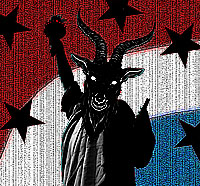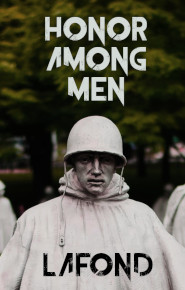Having looked for information on Caucasian slavery in Colonial America for 25 years, convinced there was enough material for a book in it, I began poking around in public [on my website] and soon had numerous archive links sent to me by readers, as well as print books. In exactly one year I have read 400,000-plus words of obscured, obfuscated, hidden, buried, misinterpreted, misrepresented and blithely dismissed accounts of how America was actually founded—with almost none of the emerging facts squaring with the wild fantasies I and every other American have been taught to believe. A year after climbing down this rabbit hole, having written three books, begun four with no end in sight and finding the pit of lies that is American History to be an ever-wider-yawning abyss too large to be accepted by any loyal American, caring liberal or staunch conservative, I consign myself to the fact that the truth about this country will remain buried—even if in open sight—until it collapses of its own weight or commits globalist politicide.
In that vein, I intend to continue researching and writing on this evermore fascinating subject. In a way this is a blessing. Indeed the American History I was taught in high school and in history books read after, was so pat, so bland, so seamless, so unlike the sordid histories of other nations, that I tended to avoid it out of sheer boredom. But now, as the holy conventions of the Lie I was born to and my ancestors were sold to propagate bursts, interest blooms.
There are many things about the very structure—intentionally or not and probably not—of our historical information that warp our perspective there should be no surprise that we were so openly misled by our handlers. Permit me to use a visual analogy that has been encroaching on my mind in the form of a mental image.
Consider an encyclopedic listing of anything. The every first and most important elements of the story will be given up front, in a slim introductory paragraph, followed by increasingly expansive and in depth treatments of the subject as it comes closer to the writer’s chronological perspective, for the author has more information on periods neared his time, which tends to enhance the natural tendency to exaggerate the importance of one’s own time in the grand sweep of history. Let’s use archery for example. The greatest leap in archery technology was the invention of the first crude bow. Nothing else even comes close. Without a self bow you don’t have a re-curve, composite, long, cross or compound bow. However, since so much more is known about these advancements and no one has the slightest idea of who, where and when the first bow was invented, we get all most no information on the origin of the tool. This same problem arises with word origins, which are often keys to understanding earlier social systems. With slavery for instance, the common modern perspective utilizes an Arabic word [slave] denoting an Eastern European sex captive of the Middle Ages and assigns its only true value as being an African agricultural captive in early modern North America, when in fact the most common terms for African American agricultural chattel were Negro [1600s], then Negro servant [1700s] and finally slave [1800s]. Since the entire mess ended in the 1800s we take the last snapshot assigned to that name and are content to believe that such was the human condition named, understood and experienced from the dawn of time until a certain date on the calendar. The term slavery and slave was generally used as a rebuke of the system, first by white servants and then by white abolitionists, and gradually adopted as a more demeaning term for the negro servant by many of his elite white owners and others opposed to his existence as a check on and threat to free white labor. The entire semantics issue of human ownership is so complex that it begged for over simplification and got it. Once over simplified any concept becomes more potent in the hands of the propagandist and so it did. Standing now, in the 400th year after the first white English boy was sold against a weight of tobacco on the docks at Jamestowne, before a single black servant was ever imported into Anglo North America, slave has but one meaning:
A black person owned and used by an English-speaking white person in North America for no other reason than his race.
Conversely, the term servant, explicitly chosen in 1607 as the term to denote all forms of human chattel by the authors of the King James Bible, is now translated by historians as employee!
This is our lot in terms of the information we reside upon. We are like a person on a beach at dusk, trying to discern the nature of the deep ocean to which we have never ventured, yet barely able to see beyond the breakers coming in at high tide, little knowing that the steeply rising ocean floor before our feet has drastically changed the nature of this watery world, with the height of the resulting waves preventing a clear view of that deep, distant body about which we wonder.
Henceforth I am splitting my exploration of this subject into various threads:
1. General historical themes, including ancient and modern enslavement, with a focus on misinterpreted and misrepresented history, beginning with The Lies that Bind Us.
2. Historic surveys of the American Plantation Period, such as the ongoing, I Am White and the Runaway series, primarily consisting of examinations and adaptations of memoirs and letters and investigations of court records, state archives and escaped servant advertisements.
3. Fictional treatments of the subject drawn from the former in the series Sold.
Thank you for your support in this area. There is no segment of current American society or government that has a vested interest in the honest exploration of the hundreds of thousands [1] of Caucasian lives that ended in unmarked graves from New Orleans to Maine, from the Atlantic Seaboard, across the Appalachians and into the Ohio Valley, lost, forgotten and denied by the nation they carved from a wilderness.
Notes
1. The estimates for 16th century Virginia and Maryland servant shipments range from 2,000-10,000, with a sure figure of 2,400 Irish sold in New Castle, Delaware in 1727, and over 4,000 in 1728. Shipments of Irish did not slacken until 1776. So, for the years from 1616 to 1776 I will use the low estimate of 2,000 whites per year, being very low for up to 13 colonies, as one single port in one small colony accounted for 4,000 in one year. However, there were certainly years when few or no servants arrived. Note that official Maryland numbers for runaway white servants from 1728-75 are 4,000. Given this number 2,000 is a good low estimate, which, if multiplied by 160 years, yields us a low estimate of 320,000 for the period. The highest average estimate I could conceive would be 5,000, which would yield 800,000, or nearly a million. My suspicion is we are looking at about a half million European souls sold in America over 200 years. In any case, even a reduction of the low estimate by a third still yields hundreds of thousands, most of whom died in bondage. Over this same period nearly 2 million Europeans were sold in North Africa.
America in Chains











Hi James,
Still here and reading you daily.
I already have America in Chains.
Please continue this important work. this history needs telling and needs to be made part of our true history if only to refute the notion that Black Africans were the only sufferers under slavery. My Irish ancestors would approve.
Dave M
Normally, Dave, I don't concern myself so much with refuting anything and am content to let lies lay. But as you suggest, the idea that only blacks have been held as slaves, and that they were held because all white people naturally hate or fear them [this is the doctrine] has become so toxic in combination with the continued American adherence to the one drop rule perpetuated by the tiny minority of elite white slaveholders, that it is currently the cause of hundreds of murders and countless beatings and rapes annually.
Ironically, no one did more to help free the black slaves than Irish Americans, who constantly helped them escape and fought harder than any other segment of the Union army.
Thanks for reading, Dave.
James - If you haven't run across it yet, you might be interested in a book written by Michael Hoffman titled "They Were White and They Were Slaves" ... JoeFour
I read it 9 times.
Thanks.